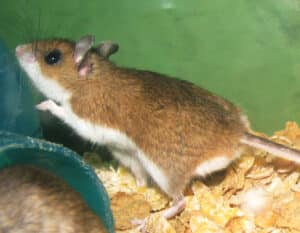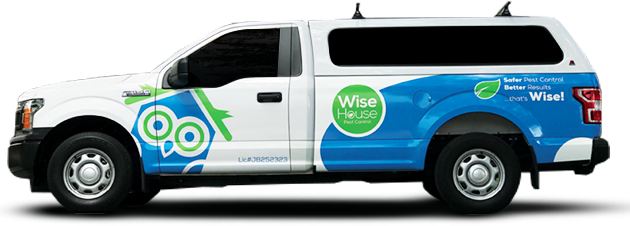Deer mice may not be the first rodents you think of when considering pests, but these small, adaptable creatures can pose significant problems for homeowners South Florida. Deer mice can easily invade homes, especially those near forests or open fields. They’re opportunistic feeders and are known to cause property damage and transmit dangerous diseases, such as hantavirus, through their droppings, urine, and saliva. Recognizing the signs of deer mice early and taking preventive measures are important in safeguarding your home and health from infestation.

Deer mice is specie of the Cricetidae family. These rodents are small North American recognized by their two-toned fur—brownish-gray on top and white underneath. Known for their large eyes and ears, they are excellent climbers and thrive in various environments, from forests to homes. These omnivores feed on seeds, fruits, insects, and household items if necessary. Deer mice are a health concern as they can transmit hantavirus, a dangerous respiratory disease, through their droppings, urine, and saliva. Early detection and prevention are essential to avoid infestation and potential health risks.
Deer mice are easily recognized by several distinct features that make them stand out among other rodent species.
Deer mice exhibit distinct behavioral traits.
Deer mice (Peromyscus maniculatus) in South Florida reproduce all year round. Although breeding commonly occurs in the warmer months.
The gestation period for deer mice is approximately 22.4 to 30.6 days. Females typically give birth to 3 to 5 young per litter, though some can produce up to 9 young under ideal conditions. The number of litters can vary from 3 to 4 litters per year, but in captivity, some females have produced as many as 14 litters annually, indicating their high reproductive potential.
Newborn deer mice are born blind, hairless, and dependent on their mother. They develop rapidly, with their fur appearing within the first two weeks, and their eyes opening between 13 to 19 days. Weaning usually occurs by 18 to 24 days, and the young mice reach full independence soon after.
Juveniles reach sexual maturity at around 6 to 8 weeks. This early maturity, combined with their high reproductive rate, allows deer mice populations to grow quickly. Lifespan of deer mice in the wild is typically less than one year due to predation and environmental factors.
Deer mice (Peromyscus maniculatus) are known carriers of several diseases that pose significant health risks to humans. Exposure to their urine, droppings, or saliva can lead to severe illnesses, primarily through inhalation of contaminated particles.
One of the most serious diseases transmitted by deer mice is Hantavirus Pulmonary Syndrome (HPS). This respiratory disease is caused by the Sin Nombre virus, which deer mice carry. Humans can contract HPS by inhaling virus particles from the rodent’s excreta. The early symptoms include fever, muscle aches, and fatigue, which can progress to severe respiratory distress, often requiring hospitalization. HPS has a high mortality rate, ranging from 30% to 50%.
While less common in North America, certain strains of hantavirus carried by rodents, such as the Seoul virus, can cause Hemorrhagic Fever with Renal Syndrome (HFRS). This disease primarily affects the kidneys and can result in acute kidney failure. It is more prevalent in Europe and Asia, but cases linked to the deer mouse have been identified in parts of North America.
Deer mice are also potential vectors of Leptospirosis, a bacterial disease that spreads through contact with contaminated water or soil. Although more commonly associated with rats, deer mice can carry the bacteria in their urine. Leptospirosis can cause symptoms ranging from mild flu-like illness to severe complications, including kidney damage or liver failure.
The most common sign of a deer mouse infestation is the presence of their pellet-shaped droppings, which are often found near food sources or along baseboards. These droppings are typically 3 to 6 mm in size and can harbor harmful bacteria and viruses. In addition to droppings, you may notice gnawed wires, chewed packaging, or shredded materials used to create nests.
Deer mice are generally active at night, so if you hear scratching or rustling sounds within your walls or ceiling, it could be a sign of an infestation. Because they are excellent climbers, they can inhabit both low and high spaces within your home, including attics and upper wall cavities.
To prevent deer mice from entering your home;
For existing infestations, snap traps are an effective and humane option for capturing deer mice. Place traps along walls where mice are known to travel, and use peanut butter or seeds as bait. Bait stations can also be used, particularly in areas where pets or children may come into contact with traps.
Professional pest control services have the expertise to identify and eliminate deer mice infestations safely and efficiently. They can perform a thorough inspection of your home to locate entry points and nests that may be hidden from sight. Pest control professionals also use safe and effective treatments, including traps, baits, and exclusion techniques, to eliminate the infestation.
Deer mice have bi-colored fur (brown on top, white underneath), larger eyes, and are more common in rural areas, while house mice are smaller, have uniform fur, and are typically found in urban settings.
Signs of deer mice include pellet-shaped droppings, gnawed food packaging, and hearing scratching or rustling sounds, particularly in attics or walls at night.
While deer mice primarily pose health risks to humans through hantavirus, they can indirectly affect pets if contaminated materials or droppings are ingested or inhaled.
If you suspect an infestation, seal entry points, set traps in common areas, and consider hiring a professional pest control service for safe removal and prevention.

Ready to send away pests without harming your pets? Getting started with Wise House Environmental Services is as easy as 1-2-3:
With Wise House Environmental Services, you get more than just effective pest control; you get peace of mind, knowing that your home is without pests and safer for your pets.
Our approach to pest control combines science with safety, offering you the kind of targeted, effective solutions that you won’t find with just any other pest control service. Our services have made a world of difference for homeowners, and we can do the same for you. Your pets will thank you for it!
We serve Port St. Lucie,Lake Worth, Boyton Beach, Palm Beachand the Treasure Coast.


© 2023 All Rights Reserved. | Sitemap